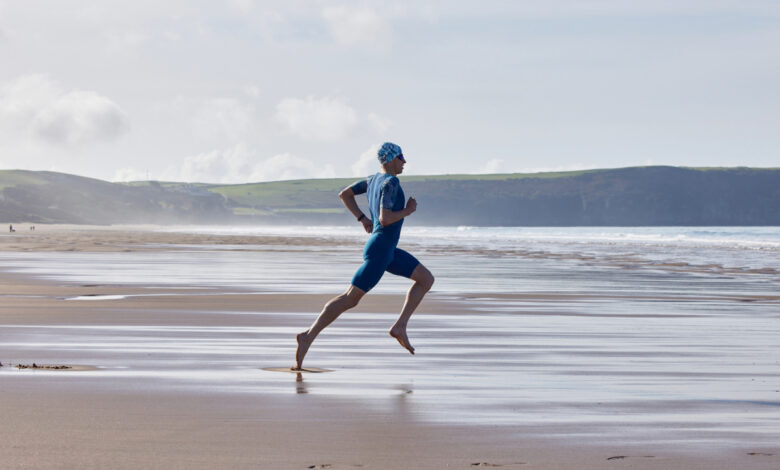Sustainable sportswear – what you need to know and the triathlon apparel brands taking steps in the right direction

Swimming, cycling or running – triathlon gives us the opportunity to get out and enjoy the natural environment around us. But did you know that the gear you wear can have an impact on the environment? As more of us look to make greener choices where we can, sustainable sportswear is on the rise.
But how do you know what to look for when you’re trying to find environmentally friendly triathlon gear? We take a look at how sportswear can have a negative impact on the environment. And outline what to look for to make the greenest possible choice when you’re shopping for new sports gear.
Is our gear harming the environments we enjoy exploring? How sportswear can contribute to environmental damage
Whether you’re a fully-fledged triathlete, or someone who enjoys open water swimming, cycling and running without finding it necessary to shove all three sports together. We partake in sports that rely on us being able to make use of and enjoy our natural environment. But in recent years, climate events have started to have a real tangible impact on triathlon training and racing.
We saw the Paris 2024 Olympic and Paralympic triathlon events in turmoil as a result of compromised water quality. Hurricane Helene reaped havoc in September, with the swim cancelled at IRONMAN Chattanooga, and IRONMAN 70.3 Augusta unable to go ahead at all. And at the start of the year Olympian Flora Duffy shared some fascinating – but alarming – data on her personal carbon footprint as a result of being an elite sportsperson.
As such, many of us are looking to do what we can, where we can, to reduce our personal carbon footprint and make greener choices. And the sportswear we choose can play a big role. An excess of 300,000 tons of clothing ends up in landfill every year. And at every stage of our clothing’s lifecycle – from manufacturing, to transportation, to garment care – apparel can have an impact on the environment. Before we dive into what to look for when trying to shop more sustainably for sportswear – first let’s take a deeper look at how our sports gear can be part of the problem.
Production and materials
The materials that go into our sportswear, and the processes to produce it, can have an impact on the environment. According to the European Parliament, textile production is estimated to be responsible for around 20% of global clean water pollution as a result of dyes and finishing products.
Sportswear is typically made from synthetic fibres so it can offer the stretch, breathability and performance we require it to. But this means the processes to manufacture these synthetic materials can also emit significant amounts of carbon, and use a lot of energy. For example, ISPO highlight that Elastane – the material that gives our sportswear stretch – is at least 85% polyurethane. “Polyurethane is a material that is extracted from crude oil and natural gas. This involves an enormous amount of energy, and the substances that are produced in the process are problematic for the environment. In addition, like most synthetic fibers, elastane cannot really be recycled.”
Polyester is another synthetic fibre often found in sportswear fabric, but this contains potentially harmful microplastics. ISPO highlight that these microplastics are released from garments during washing. Ending up in lakes, rivers and oceans which causes damage to our environment and means plastic enters the food chain during the garment’s use phase. They also highlight that materials such as Polyester take hundreds of years to degrade, and when they do so microplastics are further released. “Once they [microplastics] are there, they cannot be removed: they do not dissolve in water and are difficult to hardly degradable.”
Lifecycle – the carbon footprint of washing your stinky sports gear
Once our gear is made, the process to get it to the shelves and then to our front doors also contributes to the carbon cost. According to stats published by Decathlon, transportation makes up 10.4% of total emissions from clothing production. And packaging is a further 8% – with three quarters of that coming from the packaging used for the final delivery of products to customers.
That data (originally from Continental Clothing Co.) also highlights that washing, tumble drying and ironing also contributes significantly to the carbon foot print of clothing. Though the majority of that does come from tumble drying and ironing, which for sportswear we’re far less likely to do. Energy cost of washing your gear aside, there’s also the microplastics consideration. Every time we wash garments made from synthetic fibres, microplastics are released and end up in the environment.
Throwaway choices
Clothing items, and sportswear in particular, can be difficult to recycle because they are typically made from a blend of several different synthetic fibres. This means the industry relies more heavily on virgin materials, and more of the garments are likely to end up in mounds of landfill.
Moving towards a circular economy – where items are reused, recycled or repurposed – has been identified as a key way that we can reduce the impact of clothing on the environment. But this is perhaps even harder in sportswear. While clothing rental in sectors such as luxury fashion is on the rise. How many of us can say we’d be happy to rent a tri suit which has already been worn by several other strangers who’ve sweated in it for a full Ironman distance race? We’re probably more likely to buy new, and get rid once we want new gear for precisely this reason. And because of the materials used in a lot of our gear, recycling the fabrics to repurpose them can be difficult. ISPO highlight a move towards bio-based materials as a promising solution: “Development is moving in the direction of bio-based synthetic fibers that can be obtained from renewable raw materials – such as bamboo. Bio-based fibers have the advantage that they can be disposed of in an environmentally friendly way without any problems.”
The sustainability challenge for sportswear brands
The challenge for triathlon apparel brands and other sportswear manufacturers is that the fabrics required to deliver the high performance we expect from our kit – stretch, durability, breathability, fast-drying, aero features – are typically made from a blend of synthetic fibres. So improving sustainability, without compromising on performance adds another layer of complication to the puzzle.
That might all sound pretty doom and gloom. But the good news is, there are sportswear brands out there who are innovating where possible and making commitments to sustainable practices. Some brands have started making use of recycled materials, including a particular form of regenerated nylon made from waste materials that would have otherwise ended up in landfill. Others are looking at their supply chain to ensure their fabric sourcing and manufacturing processes are as green as possible.
If you’re looking for sustainable sportswear to make your triathlon wardrobe greener, we take a look at some of the key considerations and highlight a few brands who are taking steps in the right direction.
Fabrics and suppliers
One of the first things to look at when you’re shopping for triathlon gear with sustainability in mind is the fabrics/materials a brand is using and the supplier they’re choosing to work with. While we’ve outlined the challenges that make it more difficult for sportswear brands to create fully sustainable products. There are brands out there who are trying to be as responsible as possible with their materials and sourcing. Look for Bluesign® and OEKO-TEX® certified materials in the product description, and where suppliers for different fabric components are listed, take a look at their individual green credentials as well as the end-product brand credentials to get a better picture of the full supply chain.
“Born Bound have taken a responsible approach to sourcing, production and manufacturing. With our existing products, we’ve tried to reduce our carbon footprint and take responsibility for how we’re producing, packing and shipping our products. We source fabrics and yarns from some of the most prestigious and responsible producers in the world. And where possible, we ensure the textiles we source are already meeting criteria set out by independent bodies such as Bluesign® and OEKO-TEX®.
We only create performance products that help our customers compete at their highest level, which requires the latest technology in textiles and new methodologies for incorporating either recycled or organic materials, but for products like tri-suits that require the most aerodynamic and state-of-the art textiles, recycled versions don’t yet exist. However, we wish to be the first to become fully sustainable with our future competition products, but for now our new Rekord Thermal Run Jersey, which launches in January 2025 is a mix of 71% recycled Polyester and Merino wool.”
Cycling brand MAAP are another example of a brand taking sustainability measures a step forward, for example by moving to environmentally friendly dyeing and finishing processes, limiting the use of Elastane and using recycled fibres.
Choosing brands who are making sustainable moves where they can, will help you to reduce your impact on the environment when you’re shopping for new gear.
Commitment to green initiatives
Keep an eye out for brands who are going beyond simply saying they’re working towards sustainability, but actually signing up to initiatives that hold them to account. Of course, signing up to sustainability initiatives alone isn’t going to solve the environmental issues around producing new sports gear. But it at least shows that a brand is taking tangible steps in the right direction.

For example, Born Bound have signed up with the Green Business Bureau which provides them with tools to self-assess their credentials and review the impact of their manufacturing processes. They also donate 1% of profits to the Oceana initiative in the USA, and Plastic Free North Devon in the UK. And similarly, UK-based brand TRI-FIT are also part of the 1% for the Planet initiative.
Packaging
As outlined by the report cited by Decathlon, the packaging used for the final delivery of products to customers makes up a significant proportion of each clothing item’s carbon footprint. So packaging is an area where brands can make small changes that may have a bigger impact.
Look for brands who make a point of discussing their packaging methods on their websites if you’re shopping online. Limiting the use of excess packaging (such as tissue paper) can help to reduce parcel weight, using recycled materials and choosing recyclable garment bags instead of plastic ones are all ways that brands can make a difference.

Premium triathlon gear made with sustainability in mind
Note: If you purchase through some links on our site, we may earn an affiliate commission.
How can we be more sustainable with our sportswear as consumers?
Aside from choosing to shop with brands who are operating with sustainability in mind in the first place. There are plenty of other things we can be doing as consumers to limit the impact of our sportswear and triathlon gear. Hundreds of thousands of tons of clothing ends up in landfill every year. So if you’re buying new, try to go for premium quality gear that you’ll be able to use for several years. While shopping for second-hands sports gear is a little more nuanced, you can find some very lightly used gear on second hand selling sites and on social media that has plenty of life (and not too many miles) in it.
If you’ve got kit in good condition that you don’t like anymore or that doesn’t fit anymore, consider donating to recycle/reuse initiatives. And for damaged gear, research repair services before you throw it out. Clothes Doctor for example, offer an online repair system where you can send clothing (including sportswear) to them for repair or alteration. And many cycling and triathlon apparel brands offer crash repair services themselves.
By choosing good quality gear that will last you a long time, and taking steps to repair or repurpose your kit instead of always buying brand new. You can save yourself a bit of money in the long run – and do your bit to help save the planet.



